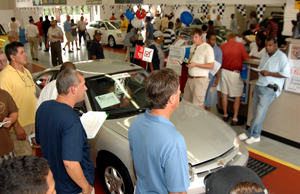
LAS VEGAS – Certainties include death, taxes and aging cars losing residual values. But lately some people aren’t so sure about the latter.
Automotive appraisers scratch their heads when they look at the high prices some used vehicles fetch these days on both the wholesale and retail markets.
“These are supposed to be depreciating assets,” but that’s not always the case when “odd-ball” vehicles defy conventional wisdom by drawing premium auction bids, says Ricky Beggs, managing editor of Blackbook, a value guide.
“We’re seeing different patterns than what you would expect” at auctions and other wholesale vehicle sources, he says. “Retention values have been real good.”
Often, dealers pay top dollar because retail buyers are lined up or in the wings.
“You wonder why this vehicle is getting so much money,” Beggs tells WardsAuto. “Did the bidder think it was a 4-wheel-drive when it was 2-wheel? Did he think the trim level was higher than it is? I’d go over and ask, and he’d say, ‘I bought at that price because it’s been sold.’ It’s basically buy-to-order.”
Moreover, dealers are willing to buy high to boost their used-car inventories, anticipating brisk turn rates.
The seller’s market isn’t expected to last forever, and it’s not across all vehicle segments. But the new year will ring in a continuation of premium used-car prices, experts say at the National Remarketing Conference here.

The phenomenon is what happens when high demand meets low supply.
Used cars have gained popularity for a couple of reasons. One, cars are made better now. They last longer and break down less often, making them less risky to buy compared with their predecessors that didn’t age well.
Two, many consumers who were new-car buyers before the recession became used-car buyers after suffering financial setbacks. They’re watching their spending more closely.
“A lot of people are hurting people out there,” says Chad Lemieux, corporate used-car director for the CAR Group, a dealership management firm. “They are making budget-conscious decisions and have become interested in older cars with higher mileage.”
U.S. consumers bought nearly 37 million used cars last year, 1.4 million more than 2009, according to Manheim Consulting. Of the 2010 total, franchised and independent dealers sold 25.8 million used units; private-party transactions accounted for 11.1 million.
Short supplies of used cars today stem from the drop in new-car sales and cutbacks on leasing a few years ago.
Used cars, particularly 2- to 3-years-old models, are in short supply because new-vehicle sales fell from 16.4 million units in 2007 to 13.4 million in 2008 to 10.6 million in 2009. Drops like that ultimately affect used-car availability.
“You sell 5 million fewer new cars in one year and that’s 5 million fewer used cars to sell today,” Beggs says.
Used-car prices will increase, again, early next year 3%-4%, depending on the segment, predicts Juan Flores, director-vehicle valuation and analytic insights at Kelley Blue Book.
Values remain high, says Jonathan Banks, executive auto analyst for the NADA Used Car Guide. “You’d think the market would be ready for a correction. But I don’t see anything to make prices go down.”
In 2008 and 2009, vehicle leasing fell out of favor with some auto makers. General Motors severely cut back on it; Chrysler ended it altogether. Leasing has rebounded today. But one result of those earlier curtailments is a vast reduction in the number of vehicles coming off 3-year leases and entering the used-car market.
“Used-car supplies will be tight in 2012, in part because there won’t be as many 3-year lease returns,” Banks says. Certified pre-owned vehicles, typically off-lease returns, “will be hard to find.”
He adds: “Dealers have tremendous ideas about how they can build up their used-car inventories, but they are going to have to pay high prices.”
Finding buyers won’t pose a problem, Banks says. “The economy will limp along, so there will be an attraction to used cars.”
It’s pretty basic, says Joe Spina, Edmunds.com’s senior manager-remarketing. “There is no significant increase in supply and demand is high and pent-up.”
But as new-car sales continue to recover and auto makers build more cars that eventually will become used-car stock, supplies will surpass the low points they are at now.
“The shortage of used cars is not going to be like it is today,” Beggs says of conditions three to four years from now.
Banks adds: “Three years out, it’s not possible for used-car prices to be where they are now.”
Flores offers a biblical analogy. “The market giveth and the market taketh away.”





